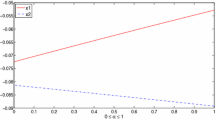Abstract
The purpose of this paper is to consider a class of mathematical programs with fuzzy implicit variational inequality constraints in finite dimension real spaces. By using the “tolerance approach” and the fuzzy set theory, we also show that solving the fuzzy mathematical program problem with fuzzy implicit variational inequality constraints is equivalent to solving a fuzzy implicit complementarity constrained optimization problem, and the fuzzy implicit complementarity constrained optimization problem can be converted to a regular nonlinear parametric programming problem. Further, a new smoothing approach based on a version of the “method of centres” with entropic regularization for solving the resulting optimization problem and our main results are presented and a numerical example is provided to illustrate our main results applying quasi-Newton line search of MATLAB software.


Similar content being viewed by others
References
Bellman, R., & Zadeh, L. A. (1970). Decision making in a fuzzy environment. Management Science, 17B, 141–164.
Chang, S. S., & Salahuddin, (2013). Existence of vector quasi-variational-like inequalities for fuzzy mappings. Fuzzy Sets and Systems, 233, 89–95.
Chang, S. S., Salahuddin, Ahmad, M. K., & Wang, X. R. (2015). Generalized vector variational like inequalities in fuzzy environment. Fuzzy Sets and Systems, 265, 110–120.
Charalammbous, C., & Conn, A. R. (1978). An efficient method to solve the minimax problem directly. SIAM Journal on Numerical Analysis, 15(1), 162–187.
Fang, S. C., & Hu, C. F. (2002). Solving fuzzy variational inequalities. Fuzzy Optimization and Decision Making, 1, 113–133.
Fang, S. C., & Peterson, E. L. (1982). Generalized variational inequalities. Journal of Optimization Theory and Applications, 38, 363–383.
Fang, S. C., & Wu, S. Y. (1996). Solving min-max problems and linear semi-infinite programs. Computers & Mathematics with Applications, 32, 87–93.
Ge, X. T., & Zhu, Y. G. (2013). A necessary condition of optimality for uncertain optimal control problem. Fuzzy Optimization and Decision Making, 12, 41–51.
Hu, C. F. (1997). Solving systems of fuzzy inequalities. Ph. D. Thesis, North Carolina State University.
Hu, C. F. (2000). Solving variational inequalities in a fuzzy environment. Journal of Mathematical Analysis and Applications, 249, 527–538.
Hu, C. F., & Fang, S. C. (1998). Solving fuzzy inequalities with concave membership functions. Fuzzy Sets and Systems, 99, 233–240.
Hu, C. F., & Liu, F. B. (2009). Solving mathematical programs with fuzzy equilibrium constraints. Computers & Mathematics with Applications, 58, 1844–1851.
Huard, P. (1967). Resolution of mathematical programming with nonlinear constraints by the method of centres in nonlinear programming. In J. Abadie (Ed.), Nonlinear programming (pp. 207–219). North-Holland: Amsterdam.
Inuiguchi, M., Ichihashi, H., & Kume, Y. (1990). A solution algorithm for fuzzy linear programming with piecewise linear membership functions. Fuzzy Sets and Systems, 34, 15–31.
Karamardian, S. (1971). Generalized complementarity problem. Journal of Optimization Theory and Applications, 8, 161–167.
Lan, H. Y. (2008). An approach for solving fuzzy implicit variational inequalities with linear membership functions. Computers & Mathematics with Applications, 55(3), 563–572.
Lee, B. S., Khan, M. F., & Salahuddin, (2010). Fuzzy nonlinear set-valued variational inclusions. Computers & Mathematics with Applications, 60(6), 1768–1775.
Muzzioli, S., & De Baets, B. (2013). A comparative assessment of different fuzzy regression methods for volatility forecasting. Fuzzy Optimization and Decision Making, 12(4), 433–450.
Nieto, J. J., Rodríguez-López, R., & Villanueva-Pesqueira, M. (2011). Exact solution to the periodic boundary value problem for a first-order linear fuzzy differential equation with impulses. Fuzzy Optimization and Decision Making, 10(4), 323–339.
Patriche, M. (2014). Bayesian abstract fuzzy economies, random quasi-variational inequalities with random fuzzy mappings and random fixed point theorems. Fuzzy Sets and Systems, 245, 125–136.
Pee, E. Y., & Royset, J. O. (2011). On solving large-scale finite minimax problems using exponential smoothing. Journal of Optimization Theory and Applications, 148(2), 390–421.
Soudmand, S., Ghatee, M., & Hashemi, S. M. (2013). sa-ip method for congestion pricing based on level of service in urban network under fuzzy conditions. International Journal of Civil Engineering, 11, 282–292.
Toyasaki, F., Daniele, P., & Wakolbinger, T. (2014). A variational inequality formulation of equilibrium models for end-of-life products with nonlinear constraints. European Journal of Operational Research, 236(1), 340–350.
Wang, H. F., & Liao, H. L. (1999). Variational inequality with fuzzy convex cone. Journal of Global Optimization, 14(4), 395–414.
Wang, X. S., & Ha, M. H. (2013). Quadratic entropy of uncertain sets. Fuzzy Optimization and Decision Making, 12(1), 99–109.
Warmuth, M. K. (2006). Can entropic regularization be replaced by squared euclidean distance plus additional linear constraints. Learning Theory, (Vol. 4005, pp. 653–654), Lecture notes in computer science.
Werners, B. (1987). An interactive fuzzy programming system. Fuzzy Sets and Systems, 23, 131–147.
Zimmermann, H. J. (1991). Fuzzy set theory and its applications (2nd ed.). Dordrecht: Kluwer.
Acknowledgments
This work was supported by Sichuan Province Cultivation Fund Project of Academic and Technical Leaders, and the Open Research Fund of Key Laboratory of Higher Education of Sichuan Province for Enterprise Informationalization and Internet of Things (2013WZJ01), and has been partially supported by Ministerio de Economia y Competitividad (Spain), Project MTM2010-15314, and cofinanced by the European Community fund FEDER. We are grateful to the reviewers for their helpful comments.
Author information
Authors and Affiliations
Corresponding author
Rights and permissions
About this article
Cite this article
Lan, Hy., Nieto, J.J. Solving implicit mathematical programs with fuzzy variational inequality constraints based on the method of centres with entropic regularization. Fuzzy Optim Decis Making 14, 493–511 (2015). https://doi.org/10.1007/s10700-015-9207-7
Published:
Issue Date:
DOI: https://doi.org/10.1007/s10700-015-9207-7
Keywords
- Fuzzy mathematical program
- Fuzzy implicit variational inequality
- Parametric membership function
- Tolerance approach
- Method of centres with entropic regularization




